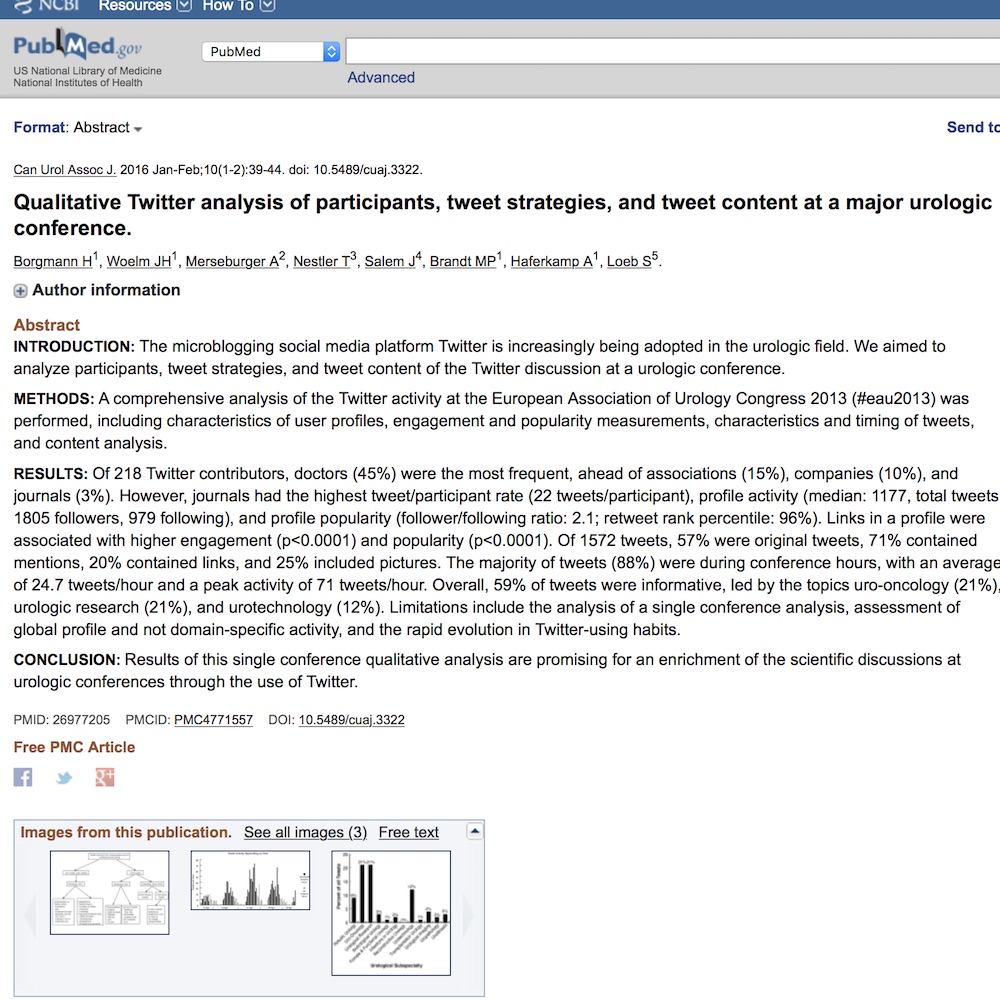Qualitative Twitter analysis of participants, tweet strategies, and tweet content at a major urologic conference
A healthcare social media research article published in Canadian Urological Association Journal, February 16, 2016
- Title
- Qualitative Twitter analysis of participants, tweet strategies, and tweet content at a major urologic conference
- Authors (alpha)
- Axel Haferkamp, Axel Merseburger, Hendrik Borgmann, Jan-Henning Woelm, Johannes Salem, Maximilian P. Brandt, Stacy Loeb, Tim Nestler
- Published
- February 16, 2016
- Journal
- Canadian Urological Association Journal
- Impact Factor
- 1.92
- DOI
- 10.5489/cuaj.3322
- Pubmed
- 26977205
- Altmetric
Abstract
The microblogging social media platform Twitter is increasingly being adopted in the urologic field. We aimed to analyze participants, tweet strategies, and tweet content of the Twitter discussion at a urologic conference. A comprehensive analysis of the Twitter activity at the European Association of Urology Congress 2013 (#eau2013) was performed, including characteristics of user profiles, engagement and popularity measurements, characteristics and timing of tweets, and content analysis. Of 218 Twitter contributors, doctors (45%) were the most frequent, ahead of associations (15%), companies (10%), and journals (3%). However, journals had the highest tweet/participant rate (22 tweets/participant), profile activity (median: 1177, total tweets, 1805 followers, 979 following), and profile popularity (follower/following ratio: 2.1; retweet rank percentile: 96%). Links in a profile were associated with higher engagement (p<0.0001) and popularity (p<0.0001). Of 1572 tweets, 57% were original tweets, 71% contained mentions, 20% contained links, and 25% included pictures. The majority of tweets (88%) were during conference hours, with an average of 24.7 tweets/hour and a peak activity of 71 tweets/hour. Overall, 59% of tweets were informative, led by the topics uro-oncology (21%), urologic research (21%), and urotechnology (12%). Limitations include the analysis of a single conference analysis, assessment of global profile and not domain-specific activity, and the rapid evolution in Twitter-using habits. Results of this single conference qualitative analysis are promising for an enrichment of the scientific discussions at urologic conferences through the use of Twitter.
Altmetric
The Altmetric Attention Score is based on the attention a research article gets on the internet. Each coloured thread in the circle represents a different type of online attention and the number in the centre is the Altmetric Attention Score. The score is calculated based on two main sources of online attention: social media and mainstream news media.
Healthcare Social Media Research
See the full list of healthcare social media research articles with data from or reference to Symplur.
#hcsmR is a collaboration between Stanford Medicine X and Symplur.


